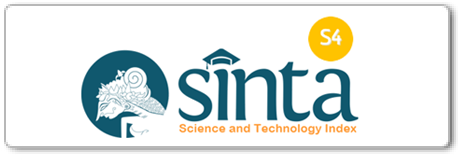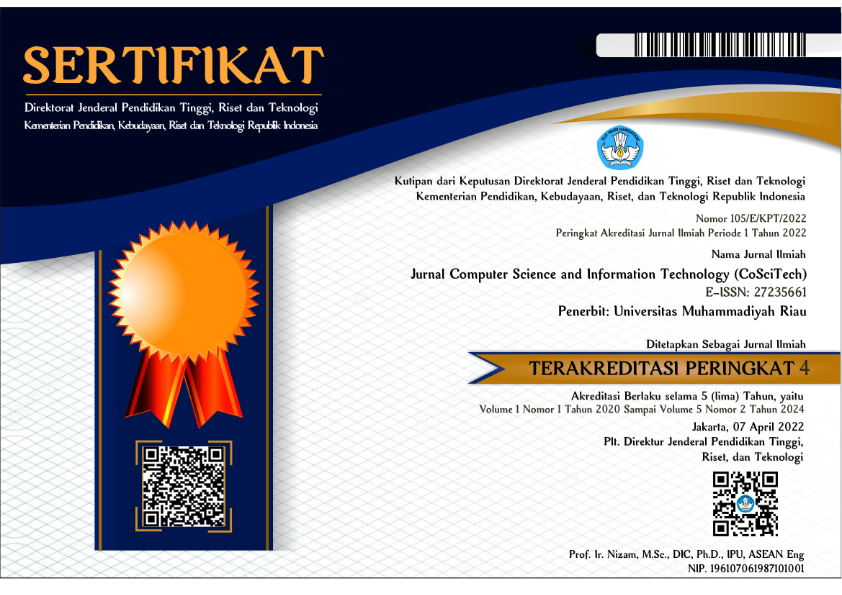ANALISA KINERJA ALGORITMA MACHINE LEARNING UNTUK PREDIKSI VIRUS HEPATITIS C
DOI:
 https://doi.org/10.37859/coscitech.v4i3.6513
https://doi.org/10.37859/coscitech.v4i3.6513
Abstract
Hepatitis C (HCV) is an RNA virus and one of the blood-borne human pathogens known as Hepatitis C. According to the World Health Organization (WHO), it is estimated that nearly 3% or 120-130 million of the world's population are infected with HCV and 3-4 million new infection cases. Early diagnosis of HCV has not been effective so most of the factors that contribute to the disease are still unclear. This study aims to implement a machine learning algorithm to identify factors that contribute to hepatitis C virus and hepatitis C virus prediction problems by comparing each algorithm to determine the best algorithm for predicting hepatitis C virus in the HCV UCI Machine Learning Repository dataset. Six classification algorithms are proposed: Naive Bayes, Decision Tree, Logistic Regression, K-Nearest Neighbor, Support Vector Machine, and Random Forest. The results show that from the accuracy value of each algorithm, the best algorithm for predicting hepatitis C virus is random forest with an accuracy rate of 98.37% and it was found that the features that contributed the most to the prediction model for HCV-infected and non-HCV patients were AST (Aspartate aminotransferase) and ALP (alkaline phosphatase).
Downloads
References
[2] L. Syafa’ah, Z. Zulfatman, I. Pakaya, and M. Lestandy, “Comparison of Machine Learning Classification Methods in Hepatitis C Virus,” J. Online Inform., vol. 6, no. 1, p. 73, 2021, doi: 10.15575/join.v6i1.719.
[3] M. B. Butt et al., “Diagnosing the Stage of Hepatitis C Using Machine Learning,” J. Healthc. Eng., vol. 2021, 2021, doi: 10.1155/2021/8062410.
[4] R. Safdari, A. Deghatipour, M. Gholamzadeh, and K. Maghooli, “Applying data mining techniques to classify patients with suspected hepatitis C virus infection,” Intell. Med., no. September 2021, 2022, doi: 10.1016/j.imed.2021.12.003.
[5] F. Mostafa, E. Hasan, M. Williamson, and H. Khan, “Statistical Machine Learning Approaches to Liver Disease Prediction,” Livers, vol. 1, no. 4, pp. 294–312, 2021, doi: 10.3390/livers1040023.
[6] L. Zhu, D. Qiu, D. Ergu, C. Ying, and K. Liu, “A study on predicting loan default based on the random forest algorithm,” Procedia Comput. Sci., vol. 162, no. Itqm 2019, pp. 503–513, 2019, doi: 10.1016/j.procs.2019.12.017.
[7] G. V. Nivaan and A. W. R. Emanuel, “Analytic Predictive of Hepatitis using the Regression Logic Algorithm,” 2020 3rd Int. Semin. Res. Inf. Technol. Intell. Syst. ISRITI 2020, pp. 106–110, 2020, doi: 10.1109/ISRITI51436.2020.9315365.
[8] A. A. Kashif, B. Bakhtawar, A. Akhtar, S. Akhtar, N. Aziz, and M. S. Javeid, “Treatment Response Prediction in Hepatitis C Patients using Machine Learning Techniques,” Int. J. Technol. Innov. Manag., vol. 1, no. 2, pp. 79–89, 2021, doi: 10.54489/ijtim.v1i2.24.
[9] H. Haga et al., “A machine learning-based treatment prediction model using whole genome variants of hepatitis C virus,” PLoS One, vol. 15, no. 11 November, pp. 1–12, 2020, doi: 10.1371/journal.pone.0242028.
[10] S. Grampurohit and C. Sagarnal, “Disease prediction using machine learning algorithms,” 2020 Int. Conf. Emerg. Technol. INCET 2020, pp. 1–7, 2020, doi: 10.1109/INCET49848.2020.9154130.
[11] Lichtinghagen, R., Klawonn, F., Hoffmann, G. 2020. HCV data Data Set [online]. Tersedia : https://archive.ics.uci.edu/ml/datasets/HCV+data. Diakses pada 26 mai 2022.














